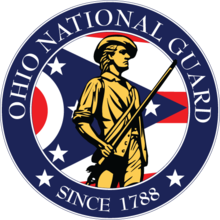Ohio National Guard
The Ohio National Guard of the US state Ohio traces its formation back to the year 1788 and is part of the National Guard of the United States established in 1903 ( acronym USNG ); thus also part of the second tier of the military reserve of the United States Armed Forces .
organization
The members of the National Guard are voluntary service payable militiamen that the governor of Ohio Mike DeWine are subject. Adjutant General of Ohio is Major General John C. Harris, Jr.
The national guards of the states have been federally and institutionally closely linked to the regular army and air force since 1903 . The units are controlled for equipment and training by the National Guard Bureau (Arlington, VA) , a semi-independent organizational unit of the Department of Defense . Current commander of the National Guard Bureau ( Chief of the National Guard Bureau ) is General Joseph L. Lengyel . In certain circumstances, with the approval of Congress, the federal level may resort to the state national guard. The President of the United States is the commander-in-chief for federal missions .
Separate from this are the State Guard , the Ohio Naval Militia and the Ohio Military Reserve , which are solely committed to the state.
Human resources and units
The Ohio National Guard consists of the two branches of the Army and the Air Force , namely the Army National Guard and the Air National Guard . In 2017, the Ohio Army National Guard had 10,445 soldiers and the Ohio Air National Guard 4,882, for a total of 15,327 soldiers.
Ohio Army National Guard units
The main units of the Ohio Army National Guard are:
- Joint Force Headquarters (JFHQ)
- 73rd Joint Task Force (73rd JTF)
- 37th Infantry Brigade Combat Team (37th IBCT)
- 16th Engineer Brigade
- 371st Sustainment Brigade
- 174th Air Defense Artillery Brigade (174th ADAB)
- 147th Regiment (Regional Training Institute)
- 52nd Weapons of Mass Destruction / Civil Support Team (WMD / CST)
Ohio Air National Guard units
The Ohio Air National Guard consists of the following active units:
- 121st Air Refueling Wing on Rickenbacker Air National Guard Base, Columbus
- 178th Wing at Springfield Air National Guard Base, Springfield
- 179th Airlift Wing at Mansfield Lahm Regional Airport, Mansfield
- 180th Fighter Wing at the Toledo Air National Guard Base, Toledo
history
The Ohio National Guard traces its roots back to the Marietta militia association of 1788. On February 19, 1803, Ohio was admitted to the United States by US President Thomas Jefferson as the 17th state, thus formally the Ohio State Militia was established. In the Toledo War of 1835, the Ohio militia units were used. Ohio stayed in the Union during the Civil War . Regiments of Ohio participated in all major battles of the civil war. Historian Andrew RL Cayton estimates that a total of 35,000 Ohio citizens died in the war. The major Union generals Ulysses S. Grant , William Tecumseh Sherman, and Philip Sheridan were all from Ohio. Since the Militia Act (1903) , the militias of the state are federal law and institutionally closely linked to the regular army and later the Air Force and performed their service in both the First and Second World War and the Vietnam War . The 112th Bombardment Squadron was established as the first unit of the Ohio Air National Guard on December 2, 1946.
The National Guard units were also used inside, as in the Akron riot in 1900. In the Kent State massacre on May 4, 1970, four students were shot at Kent State University and nine were injured, some seriously, as the Ohio National Guard opened fire on the crowd of unarmed protesters during a demonstration against the Vietnam War.
Web links
literature
- Andrew Robert Lee Cayton: Ohio. The History of a People. Ohio State University, 2002.
- Roy Morris, Jr. Sheridan: The Life and Wars of General Phil Sheridan . New York: Crown Publishing, 1992.
Individual evidence
- ↑ GENERAL JOSEPH L. LENGYEL .
- ^ DoD Personnel, Workforce Reports & Publications . DoD. Retrieved September 25, 2017.
- ↑ Cayton (2002), p. 129.
- ↑ Morris (1992), pp. 10-11.
- ↑ Cayton (2002), pp. 128-129.
- ↑ James Parker: The Militia Act of 1903 , JSTOR, The North American Review, August 1, 1903.
- ^ Carole A. Barbato: This We Know: A Chronology of the Shootings at Kent State, May 1970. Kent State University Press, Kent 2013.

